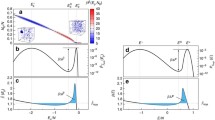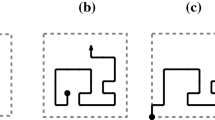Abstract
In order to better understand the geometry of the polymer collapse transition, we study the distribution of geometric clusters made up of the nearest neighbor interactions of an interacting self-avoiding walk. We argue for this new correlated percolation problem that in two dimensions, and possibly also in three dimensions, a percolation transition takes place at a temperature lower than the collapse transition. Hence this novel transition should be governed by exponents unrelated to the θ-point exponents. This also implies that there is a temperature range in which the polymer has collapsed, but has no long-range cluster structure. We use Monte Carlo to study the distribution of clusters on the simple cubic and Manhattan lattices. On the Manhattan lattice, where the data are most convincing, we find that the percolation transition occurs at ω p =1.461(3), while the collapse transition is known to occur exactly at ω θ =1.414.... We propose a finite-size scaling form for the cluster distribution and estimate several of the critical exponents. Regardless of the value of ω p , this percolation problem sheds new light on polymer collapse.
Similar content being viewed by others
REFERENCES
P. Flory, Principles of Polymer Chemistry (Cornell University Press, Ithaca, 1953).
P.-G. de Gennes, J. Physique Lett. 36:L55 (1975).
J. des Cloizeaux and G. Jannink, Polymers in Solution (Clarendon Press, Oxford, 1990).
P.-G. de Gennes, Phys. Lett. 38A:339 (1972).
P.-G. de Gennes, J. Physique Lett. 39:L299 (1978).
A. Coniglio, C. N. Nappi, F. Peruggi, and L. Russo, J. Phys. A. 10:205 (1977).
Y. Zhou, C. K. Hall, and M. Karpluts, Phys. Rev. Lett. 77:2822 (1996).
R. M. Bradley, Phys. Rev. A 39:3738 (1989).
R. M. Bradley, Phys. Rev. A 41:914 (1990).
T. Prellberg and A. L. Owczarek, J. Phys. A. 27:1811 (1994).
P. P. Nidras and R. Brak, J. Phys. A. 30:1457 (1997).
D. Stauffer and A. Aharony, An Introduction to Percolation Theory (Taylor and Francis, London, 2nd ed., 1992).
R. Brak and A. L. Owczarek, J. Phys. A. 28:4709 (1995).
J. Hoshen and R. Kopelman, Phys. Rev. B. 14:3438 (1976).
I. Majid, N. Jan, A. Coniglio, and H. E. Stanley, Phys. Rev. Lett. 52:1257 (1984).
J. Lyklema and K. Kremer, J. Phys. A. 17:L691 (1984).
K. Kremer and J. Lyklema, J. Phys. A. 18:1515 (1985).
M. C. Tesi, E. J. J. Van Rensburg, E. Orlandini, and S. G. Whittington, J. Stat. Phys. 82:155 (1996).
N. Madras and A. D. Sokal, J. Stat. Phys. 50:109 (1988).
P. Grassberger and R. Hegger, J. Chem. Phys. 102:6881 (1995).
M. C. Tesi, E. J. J. van Rensburg, E. Orlandini, and S. G. Whittington, J. Phys. A. 29:2451 (1996).
Author information
Authors and Affiliations
Rights and permissions
About this article
Cite this article
Brak, R., Nidras, P.P. & Owczarek, A.L. Cluster Structure of Collapsing Polymers. Journal of Statistical Physics 91, 75–93 (1998). https://doi.org/10.1023/A:1023083903287
Issue Date:
DOI: https://doi.org/10.1023/A:1023083903287




